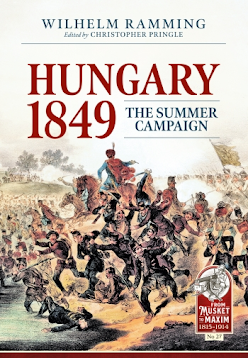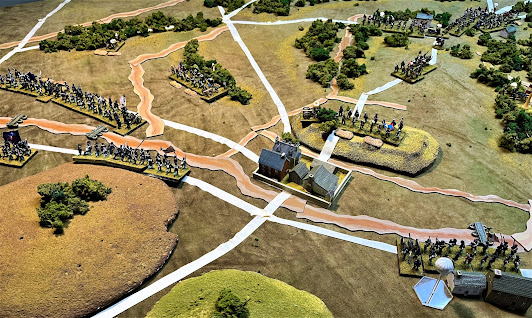What Napoleonic wargamer worth his salt doesn't aspire to refight Borodino? The emblematic battle of Napoleon's doomed invasion of Russia is as grand and glorious as Napoleonics gets. (And as grim and horrible: some 70,000 of the 250,000 on the field were killed or wounded in this sanguinary contest.)
We last tried it in 2018. After that playtest, Mark revised his scenario. As if his Tyrol game were not enough fun for one Christmas holiday, he then rolled out Borodino for us last week. (Having also played it with Colin in the interim, per Colin's blog post here.) "Us" was just 2.5 players: Mark as the Russians, me as the French, with Crispin commanding the French left for the first half of the game. Despite being short-handed, we rattled through and finished in about four hours of play - and most excellent play it was.
The short summary is this. We started with a big right hook around the fleches and a pinning attack on the Raevsky redoubt. We shifted pressure to the centre to distract Russian reserves, then stormed the fleches from the south. Poniatowski and Murat got far enough round on the right to threaten the Russian line of communications, but endless Russian reserves eventually stalled them, while more Russians menaced our own LOC on our left. The climax saw the Garde Impériale committed to counter that and attempt to storm Borodino for the one more objective needed for a French win. They came within a moustache whisker of getting in, but Russian artillery made the difference. Result: an epic, tense, gripping, see-sawing, honourable draw.
The following photos give a bit more detail. Skip past them if you want to get straight to my reflections at the end.
La Grande Armée: Davout's corps contemplates the Rajevski redoubt and the fleches.
Figures are 6mm Baccus from Mark's collection.
The battlefield is dominated by the high ground crowned by the Raevsky redoubt (left centre) and fleches (right centre), flanked by the villages of Borodino (across the river to the left) and Utitsa (in front of the woods to the right). Russian opolchenie militia hold the woods, while massed reserves are on the high ground to the rear and lining the river top left. French in the lower half of pic, L to R: Eugene, Ney, Davout, Poniatowski, backed up by Murat's cavalry and with Junot about to arrive. From these starting positions, we broadly advanced everything at 45 degrees to the right, leaving just one division facing Borodino, so that we could weight our right hook through the woods on the south.
Attacker's view of the fleches. That gun on the left looks worryingly like an 1870 Krupp, manned by Bavarians! (This big game stretched Mark's collection a bit.)
The garrison of the Raevsky redoubt. We had three or four goes but never managed to take this.
Opening clash on the right. We clattered unceremoniously into the Russians, ejected them from Utitsa, and smashed the militia back. This set us up nicely to wheel left and outflank the fleches.
Less success in front of the Raevsky redoubt, where Crispin's pinning attacks took painful casualties from murderous Russian cannon fire.
Our right hook progresses. On the far right, the militia are being pursued through the woods. Top right of picture, the two units nearest the road are Poniatowski's and Murat's men taking the line of communications objective (white counter on the road). Left of pic, that big solid line on the hill is Davout's and Junot's corps, about to storm the fleches. Top left corner, the units with yellow cubes are French as well, in post-assault disorder having punched into the Russian centre. Looking good for Napoleon!
Same turn as the previous pic: Eugene and Ney balked in front of the Raevvsky redoubt. Top left are the first waves of Russian reserves approaching to spoil our fun. By the stream confluence lower right: Napoleon himself overseeing our punch in the centre.
And now we skip forward a few turns to see the climactic assault by the Imperial Guard. The division on the left has been repelled with loss; that on the right, supported by the guard cavalry, has fought its way across the stream but not quite had enough impetus to get into Borodino (top right).
Reflections:
Majestic! This was a larger game than normal. Our typical BBB scenarios have maybe 15 units a side. This was more like 25 a side (plus artillery). That meant the whole game felt grander. When you need to shift a corps from the centre to the flank, moving two units rather than one somehow makes it a more momentous decision. Similarly when multiple Russian reserve units were released, it was more daunting than if it had just been one or two. The ebb and flow of the battle happened in great waves of units. It really captured the magnificent, epic, majestic feel you want for such a major battle. I wrote a brief essay on granularity in wargames. Borodino is evidently a case where extra granularity enhances the flavour. Hard to believe that 6mm figures on 6'x4' could provide such a sense of grandeur, but just ... wow.
Reserves. This is something I covered in a recent "Reflections on Wargaming" essay. They were an important feature in this game. Half the Russian force was not allowed to move for the first few turns, representing Russian uncertainty over where the hammer was going to fall, while the French received reinforcements most turns as troops arrived on the battlefield, culminating with the Old Guard. This helped to give the battle a definite shape and ebb and flow and tell a story.
Have a plan! Crispin and I conferred at the start, formulated a plan and stuck to it. Having a clear concept of operations made the decisions each turn easier. It worked well enough to give us a shot at victory on the last turn.
Lulls in the battle. In real C19 battles, it was very rare for every formation to be moving at once. Either because of fatigue considerations, or because of limited information, or command focus and command and control issues, in C19 'impulse warfare' some formations would sit passively while others were attacking, etc. Some rulesets try to represent this with mechanisms such as command points, initiative systems, cards, etc. By comparison, you could criticise BBB in this respect, in that theoretically you could move every unit every turn. However, in this Borodino game at least, it was notable that a major lull arose entirely naturally. There was a point in the second half of the battle where the French right had extended as far as it could, had taken some objectives, and had established itself in a line along high ground. The Russians there had been driven back behind a stream, where they too established a line, brought up reserves, and recovered lost bases. Although each side could have attacked to gain or regain further objectives on that flank, neither was inclined to do so. This felt very real (and looked good on the table).
Shot And Shield Supercast OK, I just had to smuggle this in. Scott Van Roekel, Grand Duke of Florida and creator of the Shot And Shield podcast on imperial-era wargaming, kindly invited me back, this time to talk about BBB and how it makes epic games like our Borodino one feasible and enjoyable. Scott is a great host and I like the style of his show, so I encourage you to have a listen yourselves and tell your friends if you enjoy it.
Before you ask: no, the scenario isn't in the BBB group files, but you might be able to get it soon. Mark has compiled a set of all Napoleon's biggest battles, which we plan to publish as another BBB scenario book.

























.jpg)



